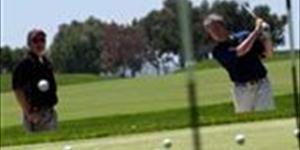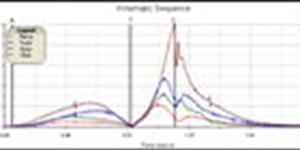IMPROVE MY GAME
Articles
Kinematic Sequence Basics
The Kinematic Sequence:

If there's one thing that I have learned over the past 15 years, it is that no two golfers have the same golf swing. But for some reason every time I meet a golfer it seems like all they want to do is visually compare their golf swing to another golfer. This type of mentality never made sense to me. Why would I want to compare myself to another golfer who probably doesn't have the same physical structure or physical capabilities as me, and therefore, could never feel what I feel when I swing the golf club. The problem comes from us not having a better way to evaluate the golf swing. What we should do is figure out if our golf swing is efficient or inefficient and then make corrective changes based on that information. Unfortunately, we have never been able to measure efficiency of the golf swing, only how it looks or its style, until now.
Haven't you ever wondered how someone like Jim Furyk won the U.S. Open with that golf swing? Or how players like Raymond Floyd or even John Daly have had such successful careers with such unorthodox golf swings. Fortunately, with the aid of new 3-D motion capture systems, researchers have been able to identify the true measurement of a good golf swing. The answer is not how close your swing looks like Ernie Els or Tiger Woods on a video camera, the answer is how efficient your swing measures compared to the best players in the world. In other words, there are a lot of ugly golf swings on the PGA Tour, but they all seem to get the job done. The question you should be asking yourself is how can I make my golf swing get the job done?
Using data collected from 3-D motion analysis systems, we are now looking at how golfers generate speed and transfer this speed or energy throughout their bodies. We have found a certain sequence or signature of how they get this speed to the club head. We call this the “Kinematic Sequence”. The amazing thing is that all great ball strikers have the same kinematic sequence or the same signature of generating speed and transferring speed throughout their body. That means if you compare Ernie Els kinematic sequence to Jim Furyk's kinematic sequence it's hard to show a difference. That is a bold statement since there is an obvious difference on a video camera between these two players. All great ball strikers begin by generating speed from their lower body and transferring this speed through their torso, into their arms, and then into the club. What style they use to complete this signature is completely unique to each player.
So the key points to know about the kinematic sequence are the following (refer to graph above):
1) There is an identical sequence of speed or energy generation for all great ball strikers. That sequence is: lower body first (red line on the graph above), trunk or torso second (green line), arms third (blue line), and the club last (maroon line). This sequence occurs during the downswing.
2) Each segment of the body builds on the previous segment, increasing speed up the chain. (Red is less than green, which is less than blue, which is less than maroon).
3) Each segment of the chain slows down once the next segment begins to accelerate. This is due to the distal segment pushing off the proximal segment. Imagine a child jumping off their dad's shoulders in a swimming pool. As the child jumps, the force rapidly slows down the dad's energy. This causes a sequential deceleration or stabilization of the segments.
4) Unorthodox styles may have no effect on your ability to generate a good kinematic sequence. In other words, Jim Furyk and Davis Love can have the same kinematic sequence. With that said, there are three things that have been shown to create efficiency or kinematic sequence breakdowns:
1) Improper swing mechanics.
2) Physical limitations
3) Improperly fit equipment.
Throughout this web site you will learn more about the kinematic sequence and how it is changing the way we analyze and work with players. The kinematic sequence is probably the number one most important piece of information that we use in assessing a new golfer.

